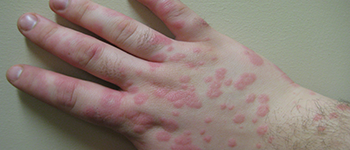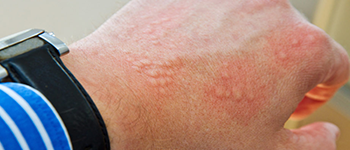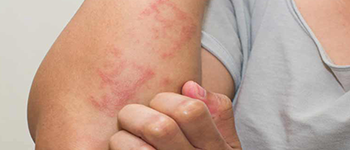Q. What is urticaria?
Urticaria, which is also known as hives, is a skin condition that is triggered by several substances and factors. It can affect about 20 per cent of people at some point in their lives. In case of urticaria, you will see an outbreak of red bumps or plaques on your skin. Urticaria is normally associated with itching and it can appear anywhere on the body. It can also affect the least expected areas like the tongue, lips, throat, and ears. Do note, however, that urticaria is not contagious as such. The triggers that cause urticaria include allergic reactions, chemicals or preservatives in certain foods, sun exposure, certain medications, and infections to insect bites and stings, intestinal parasites, and even pollen.
Q. What are the different urticaria types?
There are two major types of urticaria – acute urticaria and chronic urticaria.
-
- Acute Urticaria
It’s a condition which doesn’t lasts more than six weeks and typically affects the face, neck, toes, fingers, and sometimes even the male genitals. The most common causes of acute urticaria are foods, medications, and/or infections.
-
- Chronic Urticaria
The hives or bumps in chronic urticaria last for more than six weeks. Identifying the cause is even more difficult in this case. In some cases, it can be due to an underlying autoimmune disorder or disease such as hepatitis, thyroid or even cancer. Remember that autoimmune urticaria accounts to 40% of chronic urticaria.
Angioedema is also a type of chronic urticaria but it affects the deeper layers of the skin.
Chronic urticaria is also further divided into spontaneous or inducible urticaria. Both spontaneous and inducible urticaria can coexist. Inducible urticaria includes,
- Symptomatic dermographism
- Cold urticaria
- Cholinergic urticaria
- Contact urticaria
- Delayed pressure urticaria
- Solar urticaria
- Heat urticaria
- Vibratory urticaria
- Aquagenic urticaria
There are different stimuli that induce these types of chronic urticaria as the name of each suggests. For example, in case of symptomatic dermographism, scratching of skin, tight clothing, or towel drying after a hot shower can induce this type of urticaria. Similarly, hot or cold water, or fresh, salt or chlorinated water can cause Aquagenic urticaria.
Understanding the type of urticaria requires a proper diagnosis which can be given by a certified professional only.
Q. How is urticaria diagnosed and what are the various urticaria treatments available?
The doctor or dermatologist will first examine the rash or hive on your skin and use the information to determine the type of urticaria. In case of chronic urticaria, the diagnosis is quite different since the tests recommended are anything from blood tests to liver function tests or thyroid function tests to determine its exact cause.
In case of acute urticaria, the treatment suggested includes non-sedating antihistamines which need to be taken regularly for a few weeks with regular checkups. There are certain antihistamines, such as cetirizine or fexofenadine, which help block the effects of histamine and reduce the hive or rash.
Those affected with chronic urticaria and/or angioedema will need to see a dermatologist immediately as it can cause potentially serious breathing difficulties. If breathing becomes difficult or in case of swelling of the tongue and lips, an epinephrine auto-injector is prescribed. In some cases, acupuncture is also found to be effective in relieving symptoms of chronic urticaria.
It is essential that you remember there are different urticaria types and treatments and only an expert will be able to diagnose your skin condition after a proper evaluation. Also remember the fact that, steroids should not be used continuously to treat urticaria. They have an adverse effect and can actually worsen the skin condition furthermore. So, refrain from self-medication and reach out to an expert dermatologist who can help you treat the condition well.

















